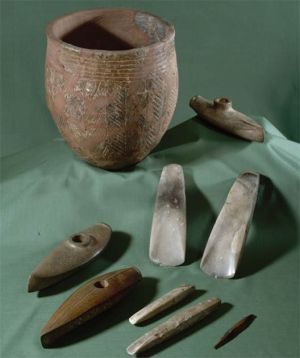Battle Axe Culture
The Battle Axe Culture (also known as as the Boat Axe Culture) was a subgroup of the Corded Ware Culture, they lived in Scandinavia, mostly in North Central Sweden, and southern Norway, and the eastern side of the Baltic Sea, mostly Southwestern Finland. They are a result of Indo European migrations into Scandinavia(Yamnaya or Pre Yamnaya peoples) mixing with the local Funnel Beaker Culture, and Pitted Ware Culture. Individuals dated to earlier in the time period generally have a greater admixture of Yamnaya DNA, while those from a later time period have less. This is generally thought to indicate a gradual assimilation of the different cultures.[1][2][3]
Culture
Lifestyle

Settlements of the Battle Axe People are generally found inland , consisting of small semi- permanent towns usually associated with a graveyard, sometimes surrounding a graveyard. There is evidence of roads and wagons, as well as short term camps, which leads researchers to conclude that they were seminomadic moving to new territory when pasture or crop ground had become depleted. Herding seems to have been preferred to farming, the evidence of crops (wheat and small grains, as well as peas and beans.) are present in the archaeological record, though they appear less frequently than before the Battle Axe settlement. Cattle, sheep, horses, hogs, and goats were all raised. There is evidence for a trade in pots and Amber across the Baltic Sea, and rock carvings from this time show ships, indicating boat building and seafaring.[4]
Diet
Beef, mutton, pork, and horse as well as wild game like reindeer and elk were eaten. Milk fat residues have been found in pots, indicating dairy was eaten, and cheese was probably eaten as well. Small grains and pulses were also eaten.[4][5]
Language
They spoke an Indo European dialect, most likely an early form of the modern Nordic languages. They are the people who brought Indo European language to Scandinavia.[5]
Burial Customs
They dug small, flat graves, in which one person was buried, usually without a barrow raised above it. Though in some instances, the megalithic graves of the Funnel Beaker People were utilized. Burials were usually laid North to South, women were laid on their right side, men on their left side. Though some burials were laid Northeast to Southwest. Gravegoods often include stone chisels, flint axes and tools, Amber beads, antler weapons, animal bones.(wildlife and cattle.) pottery, and of course, the axes for which they are named. Dogs also appear in the graves fairly often while horses and wagons appear less often, leading researchers to speculate that riding and wagons had become less important and dogs had gained significance.[2][4][5]
Migrations and Relationships to Modern Peoples
The Battle Axe people are the ancestors of the modern Nordic people, as well as the modern Nordic languages. The most common male haplogroup among them was the R1 a haplogroup, as a result of their mixing with the local Hunter Gatherers. Genetically they were a mix of Pontic Caspian Steppe Herders, European Hunter Gatherers, and Early Neolithic Farmers . The Pontic Caspian Steppe HerderDNA is most likely of Yamnaya descent (through the Corded Ware People.). The European Hunter Gatherer and Early Neolithic Farmer DNA is from the Funnel Beaker and Pitted Ware Cultures. They may also be the originators of the hammer wielding god archetype (Thor for the Nordics, Perun for the Slavs ,Ukko for the Finns) because of the apparent ritualistic/religious significance of the battle ax, as indicated by their presence in the burials of the time.[1][2][3][5]
- ↑ 1.0 1.1 Dan Davis History, The Stone Axe Of Neolithic Europehttps://youtu.be/X1PduS2ocl8?si=dRyOj7hoV2BdUZmN
- ↑ 2.0 2.1 2.2 The Study Of Antiquity and the Middle Age, The Battle Axe Culture and Indo European Migrations https://youtu.be/B1uZh7J0M3k?si=3dmt7at66hbeff9O
- ↑ 3.0 3.1 https://royalsocietypublishing.org/doi/10.1098/rspb.2019.1528
- ↑ 4.0 4.1 4.2 https://indo-european.info/game-clans-clash-chiefs.pdf
- ↑ 5.0 5.1 5.2 5.3 https://www.ancient-origins.net/human-origins-science/battle-axe-culture-0013895
